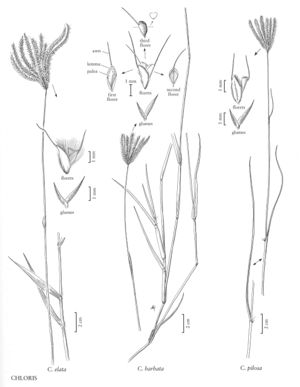Difference between revisions of "Chloris pilosa"
FNA>Volume Importer |
FNA>Volume Importer |
||
| Line 15: | Line 15: | ||
-->{{Treatment/Body | -->{{Treatment/Body | ||
| − | |discussion=<p>Chloris pilosa is native to equatorial Africa, but it is sometimes planted for forage. It has been collected in Kleberg County, Texas, possibly from an experimental forage planting; it is not known to be established in the Flora region.</p> | + | |discussion=<p><i>Chloris pilosa</i> is native to equatorial Africa, but it is sometimes planted for forage. It has been collected in Kleberg County, Texas, possibly from an experimental forage planting; it is not known to be established in the Flora region.</p> |
|tables= | |tables= | ||
|references= | |references= | ||
| Line 24: | Line 24: | ||
-->{{#Taxon: | -->{{#Taxon: | ||
name=Chloris pilosa | name=Chloris pilosa | ||
| − | |||
|authority=Schumach. | |authority=Schumach. | ||
|rank=species | |rank=species | ||
| Line 31: | Line 30: | ||
|basionyms= | |basionyms= | ||
|family=Poaceae | |family=Poaceae | ||
| − | |illustrator=Linda A. Vorobik | + | |illustrator=Linda A. Vorobik;Annaliese Miller |
| + | |illustration copyright=Utah State University | ||
|reference=None | |reference=None | ||
|publication title= | |publication title= | ||
|publication year= | |publication year= | ||
|special status= | |special status= | ||
| − | |source xml=https:// | + | |source xml=https://jpend@bitbucket.org/aafc-mbb/fna-data-curation.git/src/f50eec43f223ca0e34566be0b046453a0960e173/coarse_grained_fna_xml/V25/V25_798.xml |
|subfamily=Poaceae subfam. Chloridoideae | |subfamily=Poaceae subfam. Chloridoideae | ||
|tribe=Poaceae tribe Cynodonteae | |tribe=Poaceae tribe Cynodonteae | ||
Revision as of 20:37, 16 December 2019
Plants annual or short-lived perennials; sometimes shortly stoloniferous. Culms 30-70(200) cm, erect or somewhat decumbent. Sheaths glabrous or sparsely to densely pilose; blades to 30 cm long, 2-10 mm wide, with coarse hairs behind the ligule and on the lower portion of the margins. Panicles digitate, with 5-9 clearly distinct or easily separable branches; branches 3-5 cm, with 5-7 spikelets per cm. Spikelets barely imbricate, pale to dark gray, often mottled when mature, with 1 bisexual and (1)2 sterile florets. Lower glumes 1.1-1.6 mm; upper glumes 1.9-2.3 mm, awned, awns to 0.3 mm; lowest lemmas 2.3-3.5 mm, broadly ovate or elliptic, keels gibbous, sides with a conspicuous glabrous or pubescent groove, margins glabrous or appressed pubescent, apices awned, awns to 6 mm; second florets 1.5-2.2 mm, widened and inflated distally, mucronate or awned, awns to 3 mm; distal florets less than 1 mm, turbinate; anthers 0.4-0.5 mm. Caryopses 1.3-1.5 mm long, 0.5-0.6 mm wide, trigonous. 2n = 20, 30.
Discussion
Chloris pilosa is native to equatorial Africa, but it is sometimes planted for forage. It has been collected in Kleberg County, Texas, possibly from an experimental forage planting; it is not known to be established in the Flora region.
Selected References
None.
